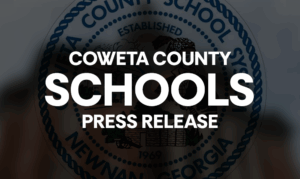The Ga. Dept. of Education (DOE) has released its first Georgia College and Career Ready Performance Index (CCRPI) which measures Georgia public schools on a broad set of academic criteria.
The new index methodology revealed that the average scores of Coweta’s elementary, middle and high schools were above the state average.
Overall, the Coweta County School System outperformed the state average for elementary, middle and high school levels on the CCRPI, said school system spokesman Dean Jackson, noting that the new CCRPI accountability system replaces the No Child Left Behind (NCLB) Adequate Yearly Progress (AYP) measurement in Georgia.
The CCRPI report measures schools and school districts on a 100-point scale made up of three major areas: “Achievement” (70 points possible), “Progress” (15 points possible) and “Achievement Gap” (15 points possible). The report measures schools based on data from the 2011-12 school year. The next CCRPI report, due this fall, will look at data from the current 2012-2013 school year.
So how did Coweta schools fare in the new index? The system’s elementary schools averaged a score of 85.2 compared to the 83.4 state average, middle schools scored 86.3 compared to the 81.4 state average while high schools scored 82.2 compared to the 72.6 state average.
A further scoring breakdown showed elementary schools ranging from a high of 94.7 at Arbor Spring and 93.1 at Thomas Crossroads to a low of 75.4 at Welch. Middle school scores ranged from a high of 94.1 at Madras to a low of 80 at Smokey Road. And high school scores ranged from a high of 89.5 at Northgate to a low of 79.3 at East Coweta.
“The CCRPI is the state’s new accountability measure and portions of it are still in the developmental stage,” said Superintendent Steve Barker. “We will continue to review this first run of data to identify our focus areas. From the initial review of the data I am encouraged by our school system’s performance.”
The CCRPI uses a much broader and more complex set of achievement data to calculate school and system achievement scores than NCLB. Generally, the CCRPI has been designed around a comprehensive definition of college and career readiness, meaning that all students graduate from high school with both rigorous content knowledge and the ability to apply that knowledge, Jackson said.
The Achievement score (70 percent of the CCRPI) is made up of three indicators, including Content Mastery (40 percent), Post High School/Middle School/Elementary School Readiness (30 percent) and Graduation Rate/Graduation Rate Predictor (30 percent).
-Content Mastery: This section looks at student achievement on standardized tests (CRCT in grades 3-8 and End of Course Tests in grades 9-12) to determine how well a school is doing with instruction.
-Post High School/Middle School/Elementary School Readiness: This section looks at areas that have proven to help students be prepared for the next level of school. Measures of this section include earning two credits in World Language, exceeding standards on state assessments and earning credit in accelerated programs.
-Graduation Rate/Graduation Rate Predictor: This section will look at a school’s four-year and five-year graduation rate.
The Progress score (15 percent of the CCRPI) is calculated based on the percentage of a school’s students demonstrating typical or high growth via Student Growth Percentiles (SGP). An SGP describes a student’s growth on state tests relative to other students statewide with similar prior achievement. A student’s growth percentile can range from 1 to 99 and every student’s SGP may earn points towards the Progress Score.
The Achievement Gap score (15 percent of the CCRPI) assigns points to schools for their progress in closing, or having small achievement gaps, on state tests between schools’ lowest 25 percent of achievers and the state average. Comparisons are made between gap size from prior year to current year and schools receive points in this section of the CCRPI for closing the achievement gap.
The Coweta County School System generally outperformed the state of Georgia in all three indicators system-wide.
Beginning in the 2013-2014 school year, schools will also receive ratings based on their financial efficiency and school climate in the CCRPI, but these ratings will be for the public’s information only and will not factor into the school’s overall CCRPI score.
The online version of the CCRPI report with a breakdown by system and school can be found at the DOE website at ccrpi.gadoe.org/2012.











Leave a Comment
You must be logged in to post a comment.